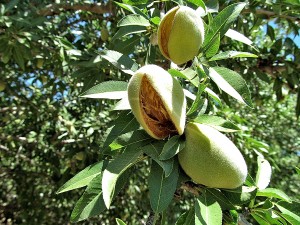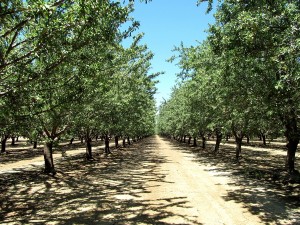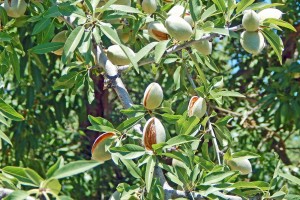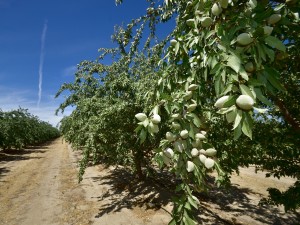
This report covers conditions and observations made between Monday, June 1 and Sunday, June 28, 2015. The next report is scheduled for Monday, August 3, 2015. However, in the event of any significant occurrences prior to that date, this site will be updated as soon as possible.
Northern Region –
Variable, but rising temperatures dominated the weather in the Sacramento Valley during June, casting quite a contrast to the mild conditions that dominated much of the previous month. Daily maximum temperatures increased steadily during the period, rising from the low to mid 80’s in the period’s opening days and peaking as high as 110 degrees during the final week of the month. Meanwhile, morning lows ranged between the mid 50’s and lower 60’s for much of the month, peaking in the upper 60’s at the end of the period. Brief showers scattered a few hundredths of an inch of precipitation over isolated areas of the region during the morning of June 10th, causing no consequence to the crop or growing conditions.
Observers are reporting the start of the hull split in the Nonpareil variety, signaling the approach of the coming harvest. This has prompted growers to begin the first round of hull split treatments for Navel Orange Worm, NOW. Many will follow with a second treatment, depending on trap counts used to monitor activity and timing of the insect’s life cycle. Poor mummy shaking condition this past winter have left an excessive number of over-wintering insects in the region’s orchards, making the timing of required treatments critical to reducing impacts on the 2015 crop. Growers have noted that their egg and pheromone traps have been very active this year, an indication of the level of activity in the orchards. Applications of bait formulations targeted at damaging ant species are also being conducted as are efforts to prepare the orchard floors for harvest.
For the most part, growers have been able to meet their orchards water needs this year, owing to the geographic location of the Sacramento Valley. While the reduction of supplies from federal and state sources have made for tight supplies, thus far, grower’s wells have largely been able to meet the demand. Growers in the areas under the tightest restrictions are predicting a relatively early harvest date, while those with adequate water are estimating that they will start shaking approximately 5 days ahead of last year. Obviously, should the current heat wave continue, the potential for water stress will also rise and orchards under the greatest stress could be pulled towards an earlier harvest. Excessive stress will also exacerbate the potential for weight loss in the crop.
Central Region –
Following an extended period of relatively mild conditions during May, temperatures were much more variable during June, with generally higher temperatures dominating much of the period. Temperatures ranged from the lower 80’s in the period’s opening days to the as high as 110 degrees during the final week of the month. The region briefly escaped the impacts from the heat on June 10th, when a weakening weather system dropped a few hundredths of an inch of rain in the northern Stanislaus and San Joaquin County area. Meanwhile, morning lows followed a similar trend, with readings ranging from the lower 50’s to the mid and upper 60’s. Winds during the period were relatively calm, rarely exceeding 10 mph.
The hull split has begun in the northern San Joaquin Valley. First nuts to split were observed along the I-5 corridor on the west side of the region during first week of June, 5 to 7 days ahead of last year. Splitting hulls can now be observed in all areas of the region, prompting growers to begin their hull split treatment programs for Navel Orange Worm, NOW, control. Tractor-drawn spray rigs can now be observed in many orchards around the region as growers work to control this serious insect pest. The poor mummy shaking conditions during the winter of 2014/15, resulting from the lack of rainfall has prompted growers to be very mindful of the potential for damage to the 2015 crop and they have been monitoring their orchards closely. Pest Control Advisors have been variable trap counts, in both the traditional egg traps used to monitor egg laying by female NOW moths and the new pheromone traps used to monitor populations of the male moths.
As has been reported continuously this year, water remains a focal point for growers in the central region. An announcement by the State Water Resources Control Board curtailing diversions of water for those with rights dating back to 1903 called water supplies for several irrigation districts, as well as landowners drawing directly from river flows into question. With the start of the hull split, growers can now withhold water from their orchards, increasing the stress levels. However, most are reluctant to do so, wanting to preserve as much weight in the kernels as possible. In many cases around the region, stress levels are already running high. Spur development, the growth that produces buds for the following crop varies with the variety. However, given the proper nutrients and adequate water, the tops of the trees will always have a cover of lush growth. If not, it is a sign that spur development within the canopy is also limited and that the potential production of subsequent crop has also been affected.
Observers are reporting that growers in the Le Grand area of Merced County have seen the productive yields of their wells reduced over the past months as water levels drop. Growers in districts with reduced supplies of surface water available are working to secure from other sources. Some districts are making limited supplies from wells available in order to get the orchards through the harvest.
Growers along the I-5 corridor, where the crop is more advanced are expecting to begin shaking in mid-July, commensurate with last year. Many are already preparing harvest equipment for the upcoming harvest. Field operations during the coming weeks will focus on making sure that the orchard floors are prepared to receive the crop. Ant bait applications have already begun in orchards with excessively high populations, as have a few treatments for web-spinning mites, where needed. Beyond harvest preparations, growers will continue to make the hard decisions required by the limited amount of water available to get them through the balance of the season.
Southern Region –
The relatively mild temperatures recorded during May gave way to much hotter conditions during June, particularly in the period’s final week. Daytime highs in the opening days of the period continued the trend established during May, with readings widely reported in the 80’s. Temperatures rose dramatically, however, with readings rising to 105 degrees by June 8th, then varying between the mid 90’s and 106 degrees for the balance of the period. Morning lows were also reported at warm levels, with readings ranging between the upper 50’s and upper 60’s. An unusual point in the southern region’s weather included showers produced by monsoonal moisture flung northward from Mexico, which brought a few hundredths of an inch of precipitation to isolated areas of Kern County on June 10th.
Hull split has begun the southern San Joaquin Valley, heralding the approach of the 2015 harvest. Treatments to control Navel Orange Worm, NOW, started at mid-month in the most advanced plantings as growers work to reduce populations of this serious insect pest. The poor mummy shaking conditions during the winter of 2014/15 has growers concerned about the potential for damage in the 2015 crop. Many are planning on multiple treatments, hoping to “bracket” the timing of the insects’ susceptible life stages to ensure adequate control. Growers are also adding materials to control web-spinning mites in plantings with increasing populations and/or weak predator populations. Time is also being dedicated towards bait applications designed to control damage species of ants, particularly Southern Fire Ants, which can feed on the nuts as they lay on the orchard floor during the harvest. All of these treatments are being conducted between operations need to prepare the orchard floor for harvest as well as irrigations.
Water concerns continue throughout the region. Observers are reporting that growers in Merced and Madera counties are facing particularly critical issues as the productive yields from their private wells continue to fall. Both areas are totally reliant on groundwater this year, given that there are no supplies of surface water available from local irrigation districts. However, recent precipitation in the Sierra Nevada watershed serving as the source of water for the Fresno Irrigation District has allowed the district to provide water for a single irrigation. Nevertheless, ground water remains the prime source of water needed to produce the 2015 crop. As shown in the photos accompanying this report, orchards around the region are showing significant signs of water stress. Salt damage, wilting trees and pre-mature defoliation can be observed in a significant proportion of the region’s orchard, particularly in Madera County.
The next few weeks will see a continuation of harvest preparations. Growers are anticipating sending shakers into the first orchards between the 15th and 20th of July, 5 to 7 days ahead of last year’s timing.



